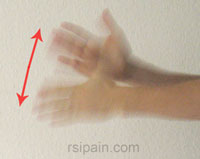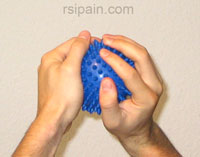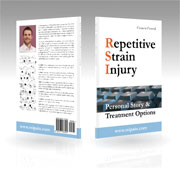Additional treatment
Please have a look at the treatment plans, so you know when and what action is appropriate.
Improve blood circulation
Since RSI is mainly due to a lack of blood flow, all circulation-promoting measures are positive. The following points will give you specific suggestions.
Jogging
Jogging regularly not only improves blood circulation, but also improves your fitness and general physical condition (which in turn is positive for the recovery of RSI). If your pain is still very strong, you can let your arms hang alongside the body while running.
Contrast baths
Fill two adjacent plastic tubs (price:
![]()
![]()
)
with hot and very cold water (if possible with ice cubes). Immerse both forearms in the hot tub for at least 3 minutes and then immediately put them into the cold water. After 15-20 seconds you start again with the hot water and then finish in the cold tub.
Simpler (but less effective) are contrast baths in the shower or in the sink. There is a recommended order: hot (right arm, from the hand to the shoulder, first the outside, then the inside), cold, hot, cold. Then the left arm.
After the last cold bath you should wear something with long sleeves and shake out the arms gently.
Sauna/steam bath
Sauna sessions stimulate blood  circulation and in combination with a subsequent cold bath form a good vascular training.
circulation and in combination with a subsequent cold bath form a good vascular training.
Keep your forearms and hands warm
Wearing long sleeved clothing helps to keep your forearms and wrists warm.
Alternatively you can wear thin gloves (price:
![]()
![]()
)
or arm warmers (price:
![]()
![]()
)
during the day and at night.
Rub your hands together
Rub your hands together quickly. The friction will warm your fingers and improve blood circulation.
Pump with your hands
Hold your arms up straight over your head  and open and close your hands very quickly - for half a minute. Bend your upper body forward and then shake out your arms until all the blood is flowed back again.
and open and close your hands very quickly - for half a minute. Bend your upper body forward and then shake out your arms until all the blood is flowed back again.
Massage ball
At my workplace there is always a massage ball (price:
![]()
![]()
)
within reach. Firstly you can warm your hands with rotating movements, secondly it supresses the burning sensation in the forearms which sometimes occurs after prolonged keyboard work.
Swelling
In the early days of severe RSI cases forearms or wrists are prone to swelling. In this case, you should definitely go to the doctor to rule out other diseases or injuries. The only sensible time to fight RSI with immobilization (wrist brace, price: ![]()
![]()
)
and anti-inflammatory tablets or creams is now - at the very beginning. If you wear wrist braces, you should not continue to wear them after the swelling has subsided, in order not to harm the mobility of the joints and your muscle strength. In exceptional cases, you can temporarily wear wrist braces in stressful situations (if they bring a significant reduction in pain).
In my experience most sufferers prefer cooling their swollen arms. After the swelling has subsided, heat is usually more pleasant (stimulate blood circulation, see above).
Relaxation techniques
A regular change between tension and relaxation is common and very useful. However, when longer periods of tension are not followed with sufficient times of relaxation, unhealthy stress develops. This can manifest itself in many ways, including headaches, impaired concentration, increased blood pressure, fatigue, aggression, insecurity and anxiety. Stressed people usually have an increased muscle tension, even if that is often not perceived by themselves. The heavily strained upper body muscles are unable to regenerate sufficiently in phases without workload.
The goal should be to not let stress determine your life. The basis for this is a good work organization. You can support reducing muscle tension by using relaxation techniques. Basically it is not so important which method you use (e.g. autogenic training, progressive muscle relaxation, qigong, yoga, biofeedback, meditation or hypnosis). You should use the technique which suits you best (or even a combination of several techniques). The more often a method is applied, the faster a relaxation can ensue. Even a break of a few minutes can then be used effectively.
A good introduction into the different techniques can be found at helpguide.org
Deep friction massage
With RSI the tendons in the elbow area may just be as sensitive to pressure as with tennis elbow. The special treatment (deep friction massage) which takes about two to four weeks is explained here in detail.
Pain diary
Each RSI sufferer should continuously record important key data to fall back on when visiting a doctor so that you can reconstruct the development over a longer period. But you should not write a conventional pain diary and make an entry every day. The constant dealing with your own pain would be counterproductive for the healing process. Limit your entries in the acute pain phase to about one per week (later even rarer). Any significant change in pain intensity, duration of pain or location of pain should be noted down. You should also write down new treatments, medications or doctor's visits. In addition, you should note the maximum time that you can perform repetitive motions (e.g. PC work) without major pain.
The longer the pain persists, the more you start to question whether your body has started to heal at all. Often the intensity of the pain has only slightly decreased, but the pain occurs much less frequently and the time you spend on the computer each day has increased steadily. Without a pain diary, it is very difficult to understand how you felt several months ago.
